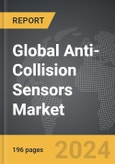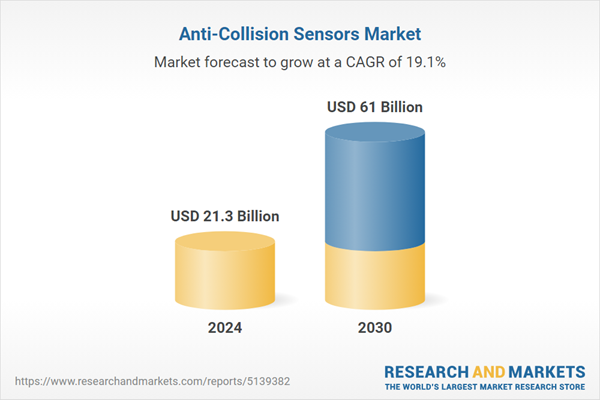The global market for Anti-Collision Sensors was valued at US$21.3 Billion in 2024 and is projected to reach US$61.0 Billion by 2030, growing at a CAGR of 19.1% from 2024 to 2030. This comprehensive report provides an in-depth analysis of market trends, drivers, and forecasts, helping you make informed business decisions. The report includes the most recent global tariff developments and how they impact the Anti-Collision Sensors market.
Segments: Technology (Radar, Ultrasonic, LiDAR, Camera, Other Technologies).
Geographic Regions/Countries: World; United States; Canada; Japan; China; Europe (France; Germany; Italy; United Kingdom; Spain; Russia; and Rest of Europe); Asia-Pacific (Australia; India; South Korea; and Rest of Asia-Pacific); Latin America (Argentina; Brazil; Mexico; and Rest of Latin America); Middle East (Iran; Israel; Saudi Arabia; United Arab Emirates; and Rest of Middle East); and Africa.
The analysts continuously track trade developments worldwide, drawing insights from leading global economists and over 200 industry and policy institutions, including think tanks, trade organizations, and national economic advisory bodies. This intelligence is integrated into forecasting models to provide timely, data-driven analysis of emerging risks and opportunities.
Global Anti-Collision Sensors Market - Key Trends and Drivers Summarized
Why Are Anti-Collision Sensors Crucial for Modern Vehicles?
Anti-collision sensors are an essential component of modern vehicles, enhancing safety by preventing accidents and collisions. These sensors detect obstacles in a vehicle's path using technologies such as radar, ultrasonic, lidar, and cameras. By providing real-time data to the vehicle's control system, they enable features like automatic braking, adaptive cruise control, and blind-spot detection. This not only helps in protecting the vehicle occupants but also reduces the risk of damage to the vehicle and surrounding property. As the automotive industry moves towards greater automation and self-driving capabilities, the role of anti-collision sensors becomes increasingly critical in ensuring the safety and reliability of these advanced systems.What Technological Breakthroughs Are Enhancing Anti-Collision Sensors?
Technological advancements are significantly enhancing the performance and capabilities of anti-collision sensors. The development of advanced radar and lidar technologies has improved the accuracy and range of obstacle detection, enabling more precise and timely responses. Additionally, the integration of artificial intelligence and machine learning algorithms allows for better interpretation of sensor data, leading to more effective collision avoidance strategies. Innovations in sensor miniaturization and the reduction of production costs are making these technologies more accessible to a wider range of vehicles, from luxury models to mass-market cars. Furthermore, advancements in wireless communication and V2X (vehicle-to-everything) technology are expanding the functionality of anti-collision systems, allowing vehicles to communicate with each other and with infrastructure to anticipate and avoid potential hazards.What Role Do Consumer Preferences and Regulations Play in the Adoption of Anti-Collision Sensors?
Consumer preferences and regulatory mandates are playing pivotal roles in driving the adoption of anti-collision sensors. With growing awareness of vehicle safety features, consumers are increasingly demanding advanced driver-assistance systems (ADAS) in their vehicles. Features such as automatic emergency braking, lane-keeping assist, and adaptive cruise control, which rely heavily on anti-collision sensors, are becoming standard in new vehicles. Regulatory bodies across the globe are also enforcing stringent safety standards that require the inclusion of such systems in vehicles. For instance, the European Union has mandated the inclusion of several ADAS features in all new vehicles, significantly boosting the demand for anti-collision sensors. These trends are encouraging automotive manufacturers to invest in and adopt the latest sensor technologies to meet both consumer expectations and regulatory requirements.Which Factors Are Fueling the Expansion of the Anti-Collision Sensor Market?
The growth in the anti-collision sensor market is driven by several factors related to technological advancements, end-use applications, and evolving industry demands. The increasing emphasis on vehicle safety and the growing implementation of stringent safety regulations are major drivers, compelling manufacturers to integrate advanced anti-collision systems into their vehicles. Technological innovations, such as improvements in radar and lidar accuracy and the incorporation of AI and machine learning, are enhancing the functionality and reliability of these sensors, making them more appealing to both consumers and manufacturers. The rising demand for autonomous and semi-autonomous vehicles, which rely heavily on anti-collision technology, is also propelling market growth. Additionally, the expanding automotive industry in emerging markets and the increasing affordability of advanced sensor technologies are broadening the market's reach. The continuous development of V2X communication technologies is further driving the adoption of anti-collision systems by enabling more comprehensive and proactive safety measures. These factors collectively contribute to a dynamic and rapidly evolving market landscape for anti-collision sensors.Report Scope
The report analyzes the Anti-Collision Sensors market, presented in terms of units. The analysis covers the key segments and geographic regions outlined below.Segments: Technology (Radar, Ultrasonic, LiDAR, Camera, Other Technologies).
Geographic Regions/Countries: World; United States; Canada; Japan; China; Europe (France; Germany; Italy; United Kingdom; Spain; Russia; and Rest of Europe); Asia-Pacific (Australia; India; South Korea; and Rest of Asia-Pacific); Latin America (Argentina; Brazil; Mexico; and Rest of Latin America); Middle East (Iran; Israel; Saudi Arabia; United Arab Emirates; and Rest of Middle East); and Africa.
Key Insights:
- Market Growth: Understand the significant growth trajectory of the Radar Technology segment, which is expected to reach US$28.0 Billion by 2030 with a CAGR of a 20.6%. The Ultrasonic Technology segment is also set to grow at 18.8% CAGR over the analysis period.
- Regional Analysis: Gain insights into the U.S. market, valued at $5.3 Billion in 2024, and China, forecasted to grow at an impressive 24.3% CAGR to reach $16.6 Billion by 2030. Discover growth trends in other key regions, including Japan, Canada, Germany, and the Asia-Pacific.
Why You Should Buy This Report:
- Detailed Market Analysis: Access a thorough analysis of the Global Anti-Collision Sensors Market, covering all major geographic regions and market segments.
- Competitive Insights: Get an overview of the competitive landscape, including the market presence of major players across different geographies.
- Future Trends and Drivers: Understand the key trends and drivers shaping the future of the Global Anti-Collision Sensors Market.
- Actionable Insights: Benefit from actionable insights that can help you identify new revenue opportunities and make strategic business decisions.
Key Questions Answered:
- How is the Global Anti-Collision Sensors Market expected to evolve by 2030?
- What are the main drivers and restraints affecting the market?
- Which market segments will grow the most over the forecast period?
- How will market shares for different regions and segments change by 2030?
- Who are the leading players in the market, and what are their prospects?
Report Features:
- Comprehensive Market Data: Independent analysis of annual sales and market forecasts in US$ Million from 2024 to 2030.
- In-Depth Regional Analysis: Detailed insights into key markets, including the U.S., China, Japan, Canada, Europe, Asia-Pacific, Latin America, Middle East, and Africa.
- Company Profiles: Coverage of players such as Analog Devices, Inc., Autoliv, Inc., Continental AG, Delphi Automotive PLC, Denso Corporation and more.
- Complimentary Updates: Receive free report updates for one year to keep you informed of the latest market developments.
Some of the 46 companies featured in this Anti-Collision Sensors market report include:
- Analog Devices, Inc.
- Autoliv, Inc.
- Continental AG
- Delphi Automotive PLC
- Denso Corporation
- Hyundai Mobis Co., Ltd.
- NXP Semiconductors NV
- Robert Bosch GmbH
- Texas Instruments, Inc.
- ZF Friedrichshafen AG
Tariff Impact Analysis: Key Insights for 2025
Global tariff negotiations across 180+ countries are reshaping supply chains, costs, and competitiveness. This report reflects the latest developments as of April 2025 and incorporates forward-looking insights into the market outlook.The analysts continuously track trade developments worldwide, drawing insights from leading global economists and over 200 industry and policy institutions, including think tanks, trade organizations, and national economic advisory bodies. This intelligence is integrated into forecasting models to provide timely, data-driven analysis of emerging risks and opportunities.
What’s Included in This Edition:
- Tariff-adjusted market forecasts by region and segment
- Analysis of cost and supply chain implications by sourcing and trade exposure
- Strategic insights into geographic shifts
Buyers receive a free July 2025 update with:
- Finalized tariff impacts and new trade agreement effects
- Updated projections reflecting global sourcing and cost shifts
- Expanded country-specific coverage across the industry
Table of Contents
I. METHODOLOGYII. EXECUTIVE SUMMARY2. FOCUS ON SELECT PLAYERSIII. MARKET ANALYSISIV. COMPETITION
1. MARKET OVERVIEW
3. MARKET TRENDS & DRIVERS
4. GLOBAL MARKET PERSPECTIVE
UNITED STATES
CANADA
JAPAN
CHINA
EUROPE
FRANCE
GERMANY
ITALY
UNITED KINGDOM
SPAIN
RUSSIA
REST OF EUROPE
ASIA-PACIFIC
AUSTRALIA
INDIA
SOUTH KOREA
REST OF ASIA-PACIFIC
LATIN AMERICA
ARGENTINA
BRAZIL
MEXICO
REST OF LATIN AMERICA
MIDDLE EAST
IRAN
ISRAEL
SAUDI ARABIA
UNITED ARAB EMIRATES
REST OF MIDDLE EAST
AFRICA
Companies Mentioned (Partial List)
A selection of companies mentioned in this report includes, but is not limited to:
- Analog Devices, Inc.
- Autoliv, Inc.
- Continental AG
- Delphi Automotive PLC
- Denso Corporation
- Hyundai Mobis Co., Ltd.
- NXP Semiconductors NV
- Robert Bosch GmbH
- Texas Instruments, Inc.
- ZF Friedrichshafen AG
Table Information
| Report Attribute | Details |
|---|---|
| No. of Pages | 196 |
| Published | April 2025 |
| Forecast Period | 2024 - 2030 |
| Estimated Market Value ( USD | $ 21.3 Billion |
| Forecasted Market Value ( USD | $ 61 Billion |
| Compound Annual Growth Rate | 19.1% |
| Regions Covered | Global |









